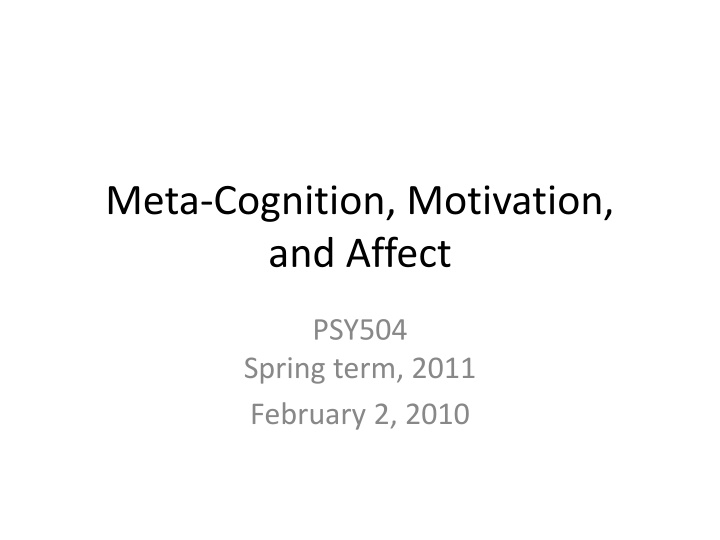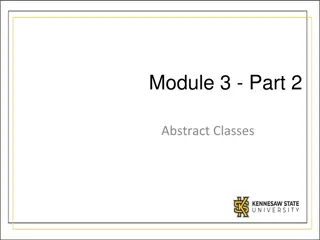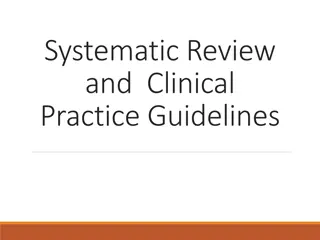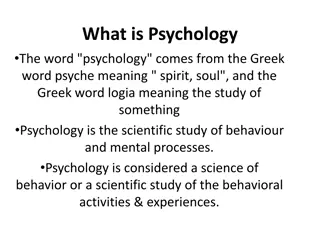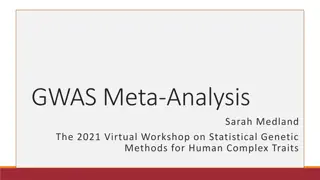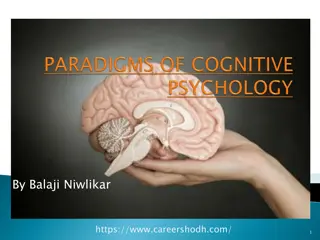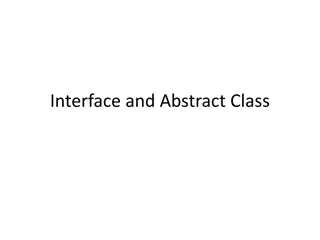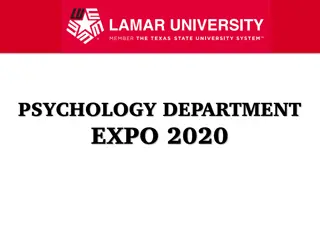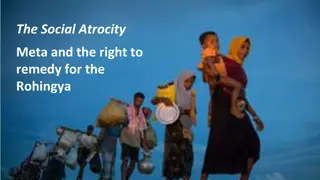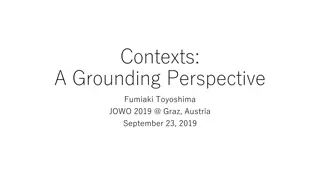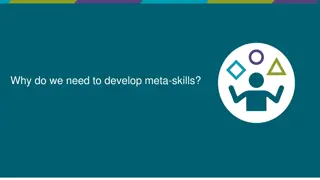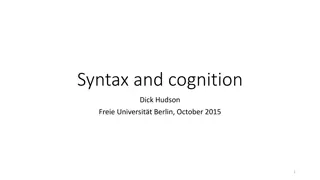Enhancing Understanding of Meta-Cognition, Motivation, and Affect in Psychology Classes
The content discusses survey responses and feedback on a psychology class focused on meta-cognition, motivation, and affect. Students shared insights on the best and worst parts of the discussions, highlighting the importance of staying on topic. The format of lectures followed by discussions was also evaluated, along with suggestions for organizing and comparing related concepts in psychology models.
Download Presentation

Please find below an Image/Link to download the presentation.
The content on the website is provided AS IS for your information and personal use only. It may not be sold, licensed, or shared on other websites without obtaining consent from the author.If you encounter any issues during the download, it is possible that the publisher has removed the file from their server.
You are allowed to download the files provided on this website for personal or commercial use, subject to the condition that they are used lawfully. All files are the property of their respective owners.
The content on the website is provided AS IS for your information and personal use only. It may not be sold, licensed, or shared on other websites without obtaining consent from the author.
E N D
Presentation Transcript
Meta-Cognition, Motivation, and Affect PSY504 Spring term, 2011 February 2, 2010
Survey Responses Thanks for your responses on the survey This really helps me make the class better
Overall How was today s class (content) 8.00 (0.82) Phew!
Overall How was today s class (discussion) 7.86 (1.35) Phew!
Comments: Discussion Best part of class: We discussed and distinguished various subtopics and nuances within them Best part: I enjoyed Andy s comment Best part: Varying viewpoints of students & professor Best part: discussions. Best part: Lots of in-depth discussion Best part: Discussion Worst part of class: In general, I think I would like to spend more time understanding an idea, its impact on the research community, before we go into a discussion Worst part of class: For this class in general, it can get off-topic
(first) Going Off-Topic This is *always* a problem in discussion-based classes I will try to be perceptive of off-topic discussions (including when I m involved in them), and will try to be more aggressive about ending them Please don t be offended if I do this to you
Discussion Throughout, or Discussion Only After Summary
Options (Vote please) Continue current practice Change format to lecture, then discussion (e.g. I will summarize more, with low discussion, and then open up discussion)
How things fit It would be nice to explore how these constructs fit into current models of psychology When there are a lot of similar interrelated concepts, I prefer having them in one big table or diagram and then compare and contrast them
How things fit I agree We ll do this next week for meta-cognition The reason I didn t do this from the start is that discussing how things inter-relate and fit in broader theory, before discussing the things themselves, can lead to unfocused discussion of those things
I wish you had talked more about Meta-cognitive agents Renkl
I wish you had talked more about Meta-cognitive agents -- we ll talk a little about this today; typically, agents are more common for motivational and affective goals Add a pic and Aleven et al s work *is* a meta- cognitive agent Renkl
I wish you had talked more about Meta-cognitive agents -- we ll talk a little about this today; typically, agents are more common for motivational and affective goals Add a pic and Aleven et al s work *is* a meta-cognitive agent Renkl Fair enough. Next time I run the class I will substitute Renkl for one of the other readings. You can get them at: http://www.sciencedirect.com/science?_ob=ArticleURL&_udi=B6VFW- 44B29XT- 1&_user=74021&_coverDate=10/31/2002&_rdoc=1&_fmt=high&_orig=search &_origin=search&_sort=d&_docanchor=&view=c&_searchStrId=1624032959 &_rerunOrigin=scholar.google&_acct=C000005878&_version=1&_urlVersion= 0&_userid=74021&md5=3b3b259f52c3b6fd70f230e3333c277c&searchtype=a http://www.cs.pitt.edu/~chopin/references/tig/AtkinsonRenklM_03.pdf http://www.iwm-kmrc.de/workshops/sim2004/pdf_files/Hilbert_et_al.pdf
Request Use blackboard or slides to keep track of important points outside scope of slides Let s vote. Who wants me to do this? Benefits: better organizer of key ideas Costs: my attention may be divided
I liked Also thanks for photos of researchers so I don t embarrass myself in conference.
I liked Also thanks for photos of researchers so I don t embarrass myself in conference. You re welcome
Its clear that you know nothing about Koedinger s work!
Scaffolding (Wood, Bruner, & Ross, 1976)
Scaffolding (Guzdial, 1994) The goal of scaffolding is (1)to enable students to achieve a process or goal which would not be possible without the support and (2)to facilitate learning to achieve without the support.
What is the difference between Scaffolding, as articulated by Wood et al and Guzdial Vygotsky s Zone of Proximal Development ?
Methods of scaffolding (Guzdial, 1994) Communicating process: Demonstrating the process with verbal annotation to highlight key points. Coaching: Watching and making comments, providing hints, reminding student of process previously communicated Eliciting articulation Essentially, requesting explanations
How does Aleven et al s Help Tutor map to Guzdial s methods?
Adaptive Scaffolding of Error Detection/Correction (Mathan, 2003; Koedinger et al., 2009)
Adaptive Scaffolding of Error Detection/Correction (Mathan, 2003; Koedinger et al., 2009)
Adaptive Scaffolding of Error Detection/Correction (Mathan, 2003; Koedinger et al., 2009) When the student makes an error in creating formula System leads student through realizing that formula is incorrect inferring why the result is different than what was expected/desired Scaffolding skill in error correction
Results Led to better learning, transfer, retention
How does This scaffolding differ from Aleven et al s scaffolding? (at a conceptual level)
Adaptive Scaffolding of SRL (Azevedo et al., 2005) A human tutor assists the learner in planning their learning by having them activate prior knowledge monitoring their emerging understanding by reporting FOK and JOL monitoring their learning progress use SRL strategies hypothesizing, coordinating informational sources, inferencing, mnemonics, drawing, summarizing
Note Azevedo et al refer to the conditions as fixed scaffolding, and adaptive scaffolding But note that the fixed scaffolding was cognitive in nature, rather than being meta- cognitive/SRL Sub-goals for learning
Results Adaptive scaffolding led to More sophisticated mental models (measured by essay on domain) and better performance on other post-test measures of learning More use of meta-cognitive/SRL strategies (measured by think-alouds)
How does This scaffolding differ from Aleven et al s scaffolding, and Mathan & Koedinger s scaffolding?
How could Azevedo et al. s scaffolding be realized in educational software?
Adapative and Non-Adaptive Scaffolding of SRL (Perry & Winne, 2006) gStudy
Non-Adaptive Scaffolding of SRL (Perry & Winne, 2006) Support for annotating content while learning, and creating notes in sophisticated fashions
Non-Adaptive Scaffolding of SRL (Perry & Winne, 2006) Support for creating indexes and glossaries creating concept maps
Non-Adaptive Scaffolding of SRL (Perry & Winne, 2006) Support for More effective chat and collaboration with fellow students, through scripts for how to collaborate
Adaptive Scaffolding of SRL (Perry & Winne, 2006) Computerized coach gLiza which talks to student (via text) and asks learner to judge whether learning and collaboration is being effective semi-randomly suggests SRL strategies uses expert system rules to suggest SRL and monitoring strategies (I could not find a paper with concrete examples of interaction from gLiza)
Results I m not aware of any papers that compare behavior in gStudy to learning outcomes, or look at overall learning impacts for gStudy There are several papers on student process within gStudy Winne argues that gStudy is a research tool rather than an intervention
How does gStudy differ from the other scaffolding we ve discussed so far?
What is missing from Methods of scaffolding (Guzdial, 1994) ? Communicating process: Demonstrating the process with verbal annotation to highlight key points. Coaching: Watching and making comments, providing hints, reminding student of process previously communicated Eliciting articulation Essentially, requesting explanations
Scaffold fading Once the learner has a grasp of the target skill, the master reduces (or fades) his participation, providing only limited hints, refinements, and feedback to the learner, who practices successively approximating smooth execution of the whole skill (Collins, Brown, & Newman, 1989) A critical piece to the concept of scaffolding is fading. If the scaffolding is successful, students will learn to achieve the action or goal without the scaffolding. For students to practice the action or goal without the scaffolding, the scaffolding must fade. However, scaffolding should not be all-or-nothing. Instead, scaffolding should be adapted to individual student needs, typically through gradual reductions in scaffolding. Students who are more capable (e.g., have more background knowledge, learn the action or goal faster) should have less scaffolding, that is, more fading of the provided scaffolding. The best scaffolding is maximally flexible providing a continuous range of support. (Guzdial, 1994)
Counter-point (Pea, 2004) According to distributed cognition theory, scaffolding is omni-present in activities, artifacts, and social organization of activities it never goes away, and doesn t really need to go away
